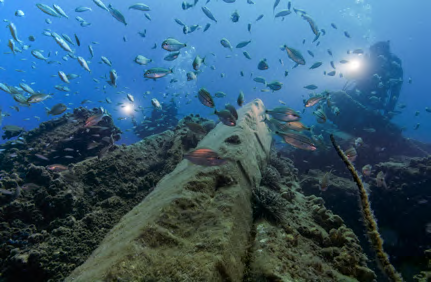A Q&A With Friends of RGV Reef Conservation Leader Gary Glick
NORTHAMPTON, MA / ACCESSWIRE / October 3, 2023 / Enbridge
Originally published in Enbridge's 2022 Sustainability Report
As part of a longstanding partnership, Enbridge is helping a conservation organization and research team explore artificial reefs' potential to sequester carbon
How did you first get involved with RGV (Rio Grande Valley) Reef?
It started with my love of fishing in the Rio Grande Valley; that's how I first got involved in conservation in this area. The reef initiative began in 2017, when we created a 1,650-acre artificial reef to help boost biodiversity in the Gulf. A
What's the current focus of the work around RGV Reef?
Researchers from the University of Texas Rio Grande Valley (UTRGV), led by Dr. Richard Kline, are carrying out a marine study to learn even more about the difference this structure is making ecologically. This is the largest artificial reef in Texas, and the idea is to understand two very important potential impacts of the reef structure: how this resource, and resources like it, restores and enhances biodiversity, and the potential for the organisms that make up this biodiversity to trap carbon. Quantifying the number of species on and around the reef structure will tell us just how successful this structure is from a biodiversity standpoint. Further, the world's oceans store more carbon than any other area on Earth, but until now, artificial reefs and the carbon sequestration potential of the encrusting organisms attracted to them have not been extensively studied.
How is the research being conducted?
The UTRGV team is using a range of approaches. They take physical samples and also use multiple sonar-based measurements to quantify the biomass at the site. Ultimately, the idea is to develop a precise estimate of its weight-and how much of that weight is composed of stored carbon. The work involves a lot of advanced equipment and analysis, so it takes resources. We're grateful that Enbridge has stayed right by our side in this latest phase of the project, providing an additional
Why is the work important? What are its implications?
Quantifying the success of the RGV Reef from a biodiversity standpoint is critical to supporting further development of the reef in an area of the Gulf that has seen a significant drop in various species of fish over the years. Quantifying the biodiversity success of this structure will also inform other artificial reef efforts around the world. Further, if the research reveals that marine habitats seeded by humans can be effective in sequestering carbon, those findings may point to an important strategy for reducing the amount of greenhouse gases in the atmosphere. Because the project is examining distinct segments of RGV Reef, which includes various shapes and structures across roughly 2.5 square miles of the Gulf floor, it may also yield insights for people in other coastal areas seeking to construct future artificial reefs. The study may tell us which configurations are most supportive of marine life. Any nation that has a coastline may be able to build artificial reefs that could help in the climate battle, while at the same time restoring precious habitat and bringing back fish and other marine habitats around the world. That's why this research is so important.
We're pleased to continue our partnership with Friends of RGV Reef, supporting work that is enhancing biodiversity and marine life in the Gulf while at the same time exploring the possible climate benefits associated with the reef.
Pete Sheffield, Chief Sustainability Officer and Vice President, External Affairs U.S., Enbridge
Learn more:
Friends of RGV Reef
Offshore carbon capture study in Texas

View additional multimedia and more ESG storytelling from Enbridge on 3blmedia.com.
Contact Info:
Spokesperson: Enbridge
Website: https://www.3blmedia.com/profiles/enbridge
Email: info@3blmedia.com
SOURCE: Enbridge
View source version on accesswire.com:
https://www.accesswire.com/789744/a-qa-with-friends-of-rgv-reef-conservation-leader-gary-glick







